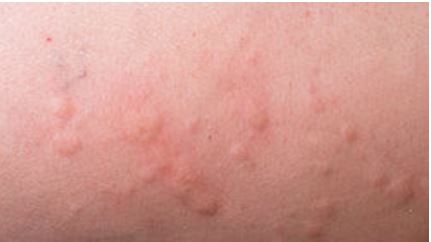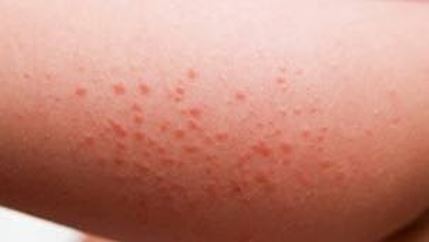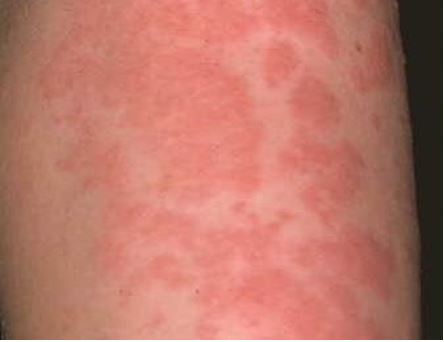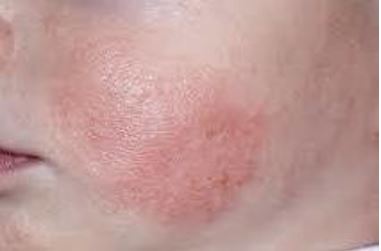Biography
Interests
Mohammad Karimi, D.M.D., B.S.
Department of Paediatric Dentistry, Sepideh Dental Clinic, Iran
*Correspondence to: Dr. Mohammad Karimi, D.M.D., B.S., Department of Paediatric Dentistry, Sepideh Dental Clinic, Iran.
Copyright © 2018 Dr. Mohammad Karimi, D.M.D., B.S. This is an open access article distributed under the Creative Commons Attribution License, which permits unrestricted use, distribution, and reproduction in any medium, provided the original work is properly cited.
Abstract
Consumption of oral Metronidazole (in form of suspension), may be related to a case of hypersensitivity which might be accompanied by signs and symptoms including skin rashes, hives (urticaria), fever, redness flushing ,and itching on the entire body. With the application of the Prick test, the allergists found that patient showed a positive result to Metronidazole.
Introduction
Metronidazole is prescribed for dental abscesses and anaerobic infections in dentistry which most of the
time is taken with Amoxicillin [1,2]. Hypersensitivity due to consumption of this drug is a rare reaction
which has seen in a few patients. Most of the time, this hypersensitivity is not a life-threatening (like rashes,
itch, flushing, fever) [3], but in some cases, it manifests as a health hazardous threat (such as Stevens-
Johnson syndrome, Lupus) [4,5]. This type of reaction can appear in the local area or the whole body. We present a case of hypersensitivity
where a child had a skin rash, hives, with itching all over her body, after taking oral Metronidazole suspension.
(Figures 1, 2, 3, 4)




Mode of Action
Metronidazole belongs to a class of drugs called Nitroimidazole antimicrobials. By inhibiting nucleic acid
synthesis it disrupts the DNA of microbial cells [6]. Hence, this function only occurs when Metronidazole
is partially reduced. This reduction usually happens only in anaerobic cells; therefore, it does not have that
much effect on human cells or aerobic bacteria [7].
History
A 5-year-old female child referred to the pediatric department with complications of skin rashes on her face
one day after dental treatment. She did not have any history of hypersensitivity in the past. When asked
about the incidence of this reaction, her parents said they noticed the red rashes have appeared on her face
and the whole body in the next morning. As her mother explained, she had hives all over her body. Except
for having a low-grade fever, the patient’s general condition seemed satisfactory.
Parents were worried if the dental procedure had caused this problem. Furthermore, they were suspicious about the injection of local anesthesia which might have an adverse reaction; however, she did not have any reaction to that before.
It is necessary to explain that looking through the patient’s file, there had been an insignificant swelling in the primary molar area with pain which was observed by our colleague on the day of the visit; PA radiography revealed this. Tooth E had a much extended carious lesion. Noteworthy, a pulpectomy was performed on that day, and due to the bacterial infection, the pediatric dentist prescribed the combination of Metronidazole with Amoxicillin to eliminate the infection.
Examination
The extra oral examination revealed the redness all over his face which was accompanied with small rashes
on the lower side of his face; close to the primary molar region. No other intraoral findings were noted. A
more detailed examination in the left side of the face suggests insignificant swelling and the possibility of an
abscess in the area of teeth D and E.
Differential Diagnosis
There are many factors can trigger this reaction. Here, we summarize the most important ones in this case
in the priority.
A - Chemical reactions (dental materials)
B - Drug allergies
C - Latex
D - Infections
E - Chronic illness such as thyroid disease
Diagnosis
After asking parents about medication use, it was found that after the dental treatment, the dentist prescribed
Metronidazole and Amoxicillin for her, and the patient is currently taking these medications. This was the first
time, she was taking Metronidazole. She did not any hypersensitivity reaction to use of Amoxicillin before.
The consultation with specialists revealed the probability of this reaction is in the result of medicine allergy
to oral Metronidazole.
Discussion
Regarding the appearance of extensive cutaneous rash in the entire body ،and on the other hands the possible
reaction to the anesthetic agent might be one of the causing factors, the referral to an allergy specialist was
the most priority. Fortunately, because the symptoms appeared not to be an emergency case, and the general
health of the patient was good, there was a time to investigate and consider these complications.
Patient did not have any medical complication because she had a new medical checkup 10 days ago. So, the likelihood of allergy due to medical illness cannot be the reason for this problem.
Parents were concerned about the reaction which might be appeared by the injection of local anesthesia. On the other side, she had a dental work a few days ago that needed a local anesthesia to be injected which no reaction was observed after that.
The latex reaction can be ruled out because the hypersensitivity was observed all over her body while the reaction to latex glove should be appeared merely on the contacted area, for example on the chin; or localized area on the cheek.
It has long been thought that there might be a link between tooth infections (such as an abscess) and urticaria. This link has not been proven yet [8]. It is rare for dental infection to spread to the skin; usually, dental infection drains along a path of least resistance, which usually leads to fistulas that occur on the gum tissue.
According to the child’s mother, her daughter had no allergic reactions to the penicillin’s group. Since the birth of her daughter, she had undergone treatments a few times with this group of antibiotics. Therefore, there is a strong possibility that Amoxicillin cannot be the cause of this hypersensitivity. One possible reason for the appearance of hives after the dental treatment is the drug hypersensitivity in case of use of antiinflammatory medication along with antibiotics.
And lastly, the allergist performed cutaneous prick tests with Metronidazole as well as epicutaneous tests with Metronidazole at different concentrations. The test revealed the positive answer.
Here we refer to two published cases of hypersensitivity to Metronidazole. This might encourage the other colleagues to do more research and investigation about this issue. In one study (hypersensitivity reaction to Metronidazole), the authors investigated this issue, and the result showed that oral provocation with Metronidazole can cause exanthema [9].
The second case reported the occurrence of general erythema after using oral Metronidazole [10].
Treatment
After consultation with the Dermatologist and Allergist specialist, Metronidazole was discontinued
immediately. The treatment with Diphenhydramine was instituted, but after one day, there was not that
much improvement of the patient’s condition. In the next day, Methylprednisolone was administered with
diphenhydramine, and her condition improved over the next 5 days. However, the symptoms subsided with
the use of Antihistamine and Corticosteroid medication; the potential hypersensitivity due to use of the
other drugs should be consider and studied.
Conclusion
Until now, to the best of our knowledge, the sensitivity of Metronidazole in children might not have been
observed. In one case, the allergic reaction was seen after taking this drug due to pulpal infection. The prick
test was applied to determine if the cause of the hypersensitivity was the usage of Metronidazole. The
result of the test was positive, hence, Metronidazole was discontinued. Of course, there was no need for
hospitalization, and the patient was treated with antihistamines and corticosteroids at home.
Follow Up
After a month, the patient referred to the clinic for a subsequent examination. Fortunately, after
discontinuation of oral suspension of Metronidazole, the redness and skin rashes on the face and the whole
body was completely disappeared.
Mohammad Karimi, D.M.D, B.S is the Head of Pediatric Dentistry at Sepideh Dental Clinic.
Bibliography

Hi!
We're here to answer your questions!
Send us a message via Whatsapp, and we'll reply the moment we're available!